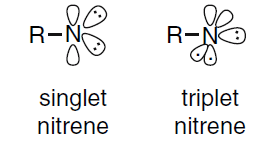
Spin multiplicity of triplet nitrene is:
(a) 1
(b) 2
(c) 3
(d) 4
Answer
501.3k+ views
Hint: To answer this question you should know that the formula which is generally used for the prediction of spin multiplicity value is (2S+1). Now you may have some idea about this term and you can predict the value for triplet nitrene.
Complete step by step answer:
First, we should know about the singlet and triplet excited states.

Singlet and triplet is derived using the equation for multiplicity, 2S+1
2S+1, where S is the total spin angular momentum (sum of all the electron spins). Individual spins are denoted as spin up (s=+1/2) or spin down (s=−1/2). If we were to calculate the S for the excited singlet state, the equation would be 2[(+1/2)+(−1/2)]+1=2(0)+1 = 1, therefore making the center orbital in the figure a singlet state.
If the spin multiplicity for the excited triplet state was calculated, we obtain 2[(+1/2)+(+1/2)]+1=2(1)+1 = 3, which gives a triplet state as expected.
Therefore, when nitrene is in the triplet state, its spin multiplicity = 3. Which makes option C the correct option.
Note: Let’s talk about some differences between singlet and triplet excited states.
A singlet or a triplet can form when one electron is excited to a higher energy level. In an excited singlet state, the electron is promoted in the same spin orientation as it was in the ground state (paired). In a triplet excited state, the electron that is promoted has the same spin orientation (parallel) to the other unpaired electron.
Complete step by step answer:
First, we should know about the singlet and triplet excited states.

Singlet and triplet is derived using the equation for multiplicity, 2S+1
2S+1, where S is the total spin angular momentum (sum of all the electron spins). Individual spins are denoted as spin up (s=+1/2) or spin down (s=−1/2). If we were to calculate the S for the excited singlet state, the equation would be 2[(+1/2)+(−1/2)]+1=2(0)+1 = 1, therefore making the center orbital in the figure a singlet state.
If the spin multiplicity for the excited triplet state was calculated, we obtain 2[(+1/2)+(+1/2)]+1=2(1)+1 = 3, which gives a triplet state as expected.
Therefore, when nitrene is in the triplet state, its spin multiplicity = 3. Which makes option C the correct option.
Note: Let’s talk about some differences between singlet and triplet excited states.
A singlet or a triplet can form when one electron is excited to a higher energy level. In an excited singlet state, the electron is promoted in the same spin orientation as it was in the ground state (paired). In a triplet excited state, the electron that is promoted has the same spin orientation (parallel) to the other unpaired electron.
Recently Updated Pages
Master Class 11 Economics: Engaging Questions & Answers for Success

Master Class 11 Business Studies: Engaging Questions & Answers for Success

Master Class 11 Accountancy: Engaging Questions & Answers for Success

Master Class 11 English: Engaging Questions & Answers for Success

Master Class 11 Computer Science: Engaging Questions & Answers for Success

Master Class 11 Maths: Engaging Questions & Answers for Success

Trending doubts
Draw a diagram of nephron and explain its structur class 11 biology CBSE

Why was the Vernacular Press Act passed by British class 11 social science CBSE

Differentiate between calcination and roasting class 11 chemistry CBSE

What is spore formation class 11 biology CBSE

Name the nuclear plant located in Uttar Pradesh class 11 social science CBSE

Nastic movement differ from tropical movement in being class 11 biology CBSE




